今回の「めぐるモノサシ」に登場するのは、株式会社アクシスのアートディレクター松野 睦(まつの むつみ)さん。モノサスとはいくつもの案件でつながり、「まるでチームメイトのよう」と、その印象を綴ってくれたのは、コーディングファクトリー部・部長の児嶋いずみです。
松野さんと初めてお仕事をご一緒させていただいたのは、2014年7月~12月の某タイヤメーカーさんのフルリニューアル案件でした。
初対面での第一印象は、「毛、赤いな。」でした。
AXISさんといえば、あの雑誌のAXISの印象がすごく強くて、一緒に仕事するのはきっとそんな感じの人たちなんだろうなー、と勝手に妄想していたところでの初対面だったので、氣志團エリア出身の私としては、いいようのない親近感を覚えたのは確かです(笑)この案件では、着手して間もなくから、AXISさんのスタッフの皆さんと弊社のディレクターで、現行サイトの全ページチェックを缶詰めで数日みっちりやるなど、最初からかなり密にやりとりをさせていただきました。そんなこんなもあり、別の会社であるとかそういう垣根のような意識は全くなく、本当に純粋に「同じプロジェクトを一緒にすすめているチームの仲間」という意識でお仕事をさせていただきました。
お仕事でかかわっていく中で、なにか筋が一本通っているなという印象を受けました。それが具体的に何なのかはわからなかったのですが、松野さんのつくりだすデザインの裏側には信頼できる考え抜かれたしっかりとしたポリシーや、デザインと生活のバランス感があるんだろうな、と思いました。
今日は、そんな「日々地味に気になっていたけど改めて聞いてみないと聞けない話」というのをインタビューでぜひうかがってみたいなと思います。
コーディングファクトリー部 部長・児嶋いずみ
自分の関わった雑誌が実際に書店に並び
目の前で買ってくれる人たちがいる体験
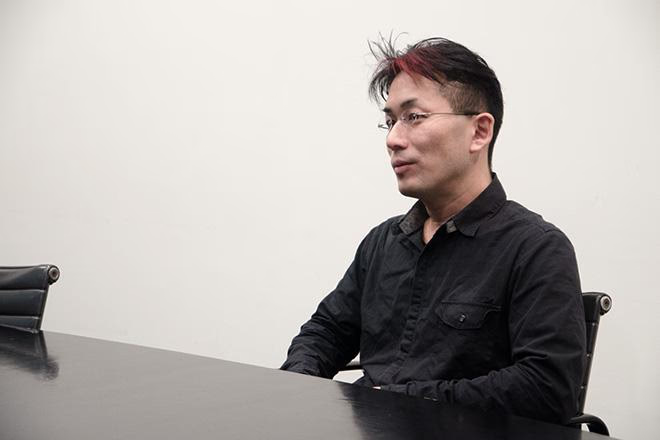
松野さん(以下:松野)
僕の仕事の始まりは、雑誌のデザインなんですよ。弊社でアルバイトを始めたのは大学生のときなんですが、その前に一社だけデザイン事務所でアルバイトをしていたんですね。
ちょうど時代的に誌面デザインの現場がDTPに変わる過渡期で、そのデザイン事務所ではまだ一部の記事はレイアウト用紙に鉛筆でデザインしていました。メインは自動車の月刊誌で、僕はぎりぎり写植を扱うデザインの現場を経験できたんですね。
しかも、雑誌のクレジットにデザイナーのひとりとして僕の名前も入れてくれたんです。美大に入ったばっかりのペエペエのアルバイトが申し訳ないと言ったんですが、周りの人たちは「キミはきちんとデザインをして、対価を得ているんだから、名前をここに載せるべきだ」と。 たぶん、それは僕を育ててやろうというはからいだったんだと思うんです。振り返ってみても、関わった雑誌が実際に書店に並び、それを手に取り、目の前で買っていってくれる人たちがいるという体験を二十歳前にできたのは、本当に大きかった。
だから、キャリアの始まりを聞かれたときは必ず、初仕事は「自動車の月刊誌です」と答えるようにしています。
児嶋
雑誌は雑誌でも御社の「AXIS」ではなかったんですね。
松野
そうなんです。ちなみに、弊社はそのときすでに PageMaker を使った DTP になっていました。
ついでに、ばーっとキャリアを話すなら、まずは雑誌をやり、平行して黎明期の Web もやるようになり、今日に至るという。社内でのポジションも少しずつ変わり、担当ページ数も減りましたが、「AXIS」は今も毎号デザイナーとして関わっています。
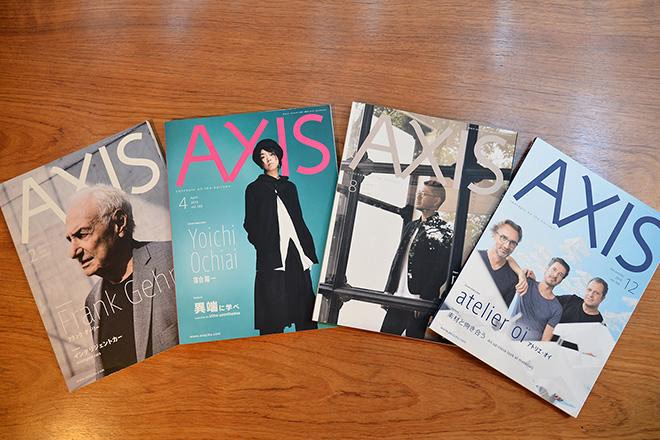
1981年からアクシスさんが発行しているデザイン情報誌「AXIS」。
隔月刊で年6冊発行されている(奇数月の1日発売)。
円熟期に向かって自然と分業が進んでいく
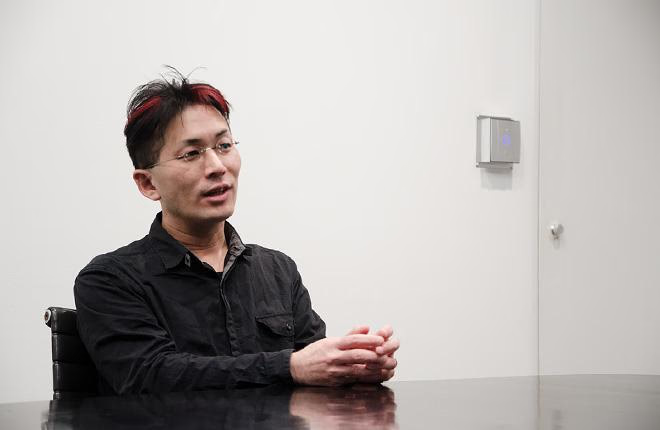
児嶋
Web に関わり始めたのはいつくらいからなんですか?
松野
当時の上司が、弊社のアルバイトに誘ってくれたのは、たぶん会社としてWebデザインに関わっていくとなったからだと思います。 直接そう言われたことはないですが、まだ「インターネット」という言葉も使われていない段階でしたから、デジタル媒体を扱えそうな若者が欲しかったのではないか、と。
最初に関わった Web の仕事はマイクロソフトが提供した最初のMSN日本版の画面デザイン。ユーザーがパソコンで独自ブラウザを立ち上げ、一定のコンテンツが楽しめるという仕組みでした。
児嶋
2000年くらいですか?
松野
1996年くらいだったと思いますから、本当の創成期。
児嶋
めちゃめちゃ創成期ですね。
松野
はい。日本国内ではホームページを持っている企業もほとんどなくて、某大手通信企業の初代コーポレートサイトのデザインも担当しました。テーブルコーディングすらあるかないかの時代で、できることは本当に限られていましたね。
児嶋
すごい!自分より前の人がいた(笑)。
松野
ははははは(笑)。同じくらいじゃないですか?
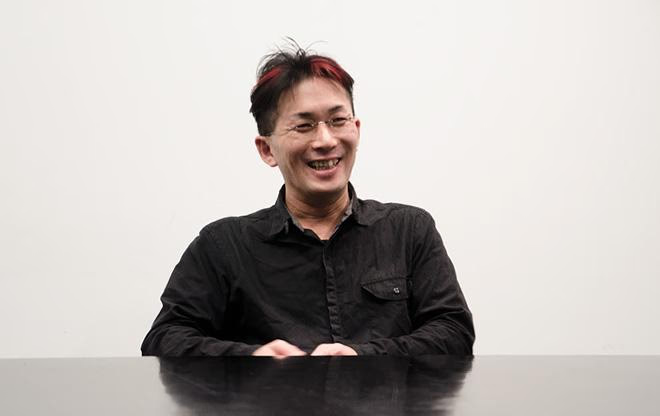
児嶋
私が入ったときは、もう現場に Dreamweaver※ はありました。
※Adobeが開発するコーディングソフト。当初 Macromedia で開発されていたが、2005年にAdobeが同社を買収。それ以降Adobe製品。
松野
たしかに、それはなかった(笑)。
児嶋
私が Web の仕事を始めたときは、ちょうど「ホームページを作ることが1つのステータス」という感じで、いろいろな会社が自社サイトを持つようになっていった頃です。だから、制作側のツールも出揃っていました。
松野
なるほど。そしたら僕の方が早いですね。多摩川でいえば上流の最初の一滴。
児嶋
湧いている感じ。
松野
湧いている感じって(笑)。
児嶋
コーディングはいつからするようになったんですか?
松野
最初からですね。当時の HTML は簡単なもので、これなら自分でも組めるかな......と独学で入り、テーブルコーディングが普通になり、世の中が「Web2.0」と言い出すくらいから分業が徐々に始まった印象です。
児嶋
たしかに、昔は Webデザイナーと言えば、コーディングもデザインも最初から最後までやる人のことでしたけど、だんだん役割が分かれていきました。
松野
Webプランナー、コーダーという役割の人はいなかったし、大抵の案件は1、2人で成り立っていました。それが、ここ5年くらいですよね。いっきに分業化されたのは。
でも、これはどのメディアでもそうで、雑誌にしても映像にしても、創成期は数人で行う仕事として始まり、成熟とともに各フェーズの技術や専門性が深まり分業化が進む。Web も自然とその流れの中にあるんだと思います。なんだか、それっぽく話すと(笑)。
児嶋
それっぽいです(笑)。
「正しいデザイン」とは、
必要なところに必要な技術が使われ、
それが効果的に機能する状態
児嶋
松野さんがデザインに軸足を置くようになったのは、どの時点でした?
松野
今もコーディングを少しはしていますが、分業を意識し始めたのは Flash のActionscript が複雑化したあたりですね。これはちょっと物議をかもす話かもしれないですけど、僕のなかではひとつの確かな分岐点で。あの頃、Flash を極めていく人たちと、Flash の使われ方に対してちょっと疑問を持つ人たちに分かれたと思うんですよ。
僕、どっちかというと Flash 万能的な考え方に疑問を持った側に近くて。社内でもFlash を突き詰めていく人たちがいたので、僕はそうじゃないサイトを担当することが多かったんですね。 そうすると、まず Flash の Actionscript から手が遠のいていき、コーディングが複雑化していくうち、「何が書かれているかはわかるんだけど、そのうちグラフィックデザイナーが抱えきれるような技術ではなくなるかもしれないな」「効率化も進んで餅は餅屋になるのかもしれないな」と。
児嶋
それで言うと、私も両方をやっていましたけど、同じ頃にコーディングのほうに移行したタイプです。
松野
やるべきことも増えて複雑化する中で、どっちかに主軸をおかないと、単純に手も回らなくなる。
児嶋
そうそう。
松野
そういった時間的な問題もあるけど、そもそも双方で求められる思考回路も違う......。
児嶋
全然違うんですよね。コーディングのことを考えながら、デザインすると制約が出てくるというか。
松野
そうなんですよ。デザインするときに、どうコーディングするかという実現性は担保しなきゃいけないんですけど、あまり気にし過ぎるとアイデアが広がらない。
児嶋
なるほど。ちなみに、松野さんのデザインポリシーってどういうところにあるんですか?
松野
多くの物には長い歴史の中で培われたある程度の「正しい姿」があると思っているんですね。
児嶋
正しい姿?
松野
例えば、すべてのサイトに Flash って必要なのかな? と。Flash を否定するつもりは全くないですけど、これは当時、僕が思っていた疑問です。一例をあげると、堅めな大企業のコーポレートサイトが Flash サイトである必要があるのか? とか。
児嶋
あああ~。
松野
必要なところに必要な技術が使われ、それが効果的に機能する状態。それがあるべき姿であって、ひとつの「正しいデザイン」だと思うんですね。実際にはクライアントやユーザーが抱える問題をきちんと解決できているかという大前提もありますし、誰が何を正しいとするかでも変わってくるとは思うんですが...。
児嶋
すごくよくわかります。
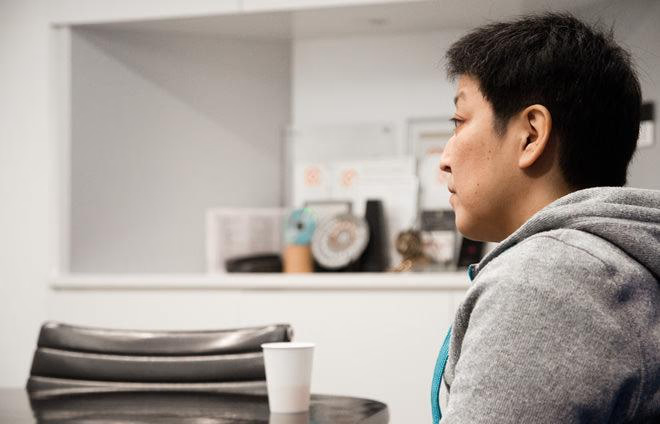
インタビューするコーディングファクトリー部 部長・児嶋
松野
ものによってはそれを「普通なデザインだね」と言う人もいるかもしれませんが、普通=みんなが使いやすいということだし、必ずしも悪いことじゃないと思っています。意外性や奇抜さは目を引くけれど、それだけが良いことではない。 デザイナーという役割に立って、本来それが目的ではない形で、不用意におもしろおかしく捻じ曲げるのはよくないなと思っています。自分としては、おもしろおかしいものよりも、「正しいもの」や「正しく進化したもの」を目指したいという思いが根幹にあります。

2006年12月、松野さんがデザインを手がけモリサワ コーポレートサイト。これによってAXISさんは数々の賞を受賞することに。第5回 東京インタラクティブ・アド・アワード銅賞、2007年度グッドデザイン賞(コミュニケーションデザイン部門)、アックゼロヨン・アワード2007グランプリおよび内閣総理大臣賞など。(詳しくはこちら)
とことん突き詰める仕事のスタイルを支えるのは
暮らしの中にあるいくつものチャンネル
児嶋
ご一緒していて本当に松野さん、忙しいですよね。しかも、「このくらいでいい」という着地点は考えず、とことんまで突き詰める仕事のスタイルのように感じました。
松野
それは児嶋さんも同じですよね?
児嶋
お互いさまかもしれませんけど(笑)。でも、松野さんはお子さんもいて、夜も比較的会社にいることが少なくなく、朝、奥様とバトンタッチしてお子さんの面倒を見て、また仕事に出てくるという。単純に、この働き方、暮らし方のスタイルがすごいな、と。
松野
まとめるのは難しいですけど、やっぱり人は育ったようにしか振る舞えないというか。児嶋さんもそうだと思いますけど、団塊ジュニアは不景気の中で社会に出た氷河期世代で、人よりも努力しないとその先にいけない風潮の中で育ちましたよね。 努力して高倍率の美大に入っても、デザイン学科の人たちが全員デザイナーになれるわけじゃありませんでしたし。 妻は高校の同級生なので、その過程をずっと見てきているから、夜遅めに帰っても遊んでいるわけじゃないと理解してくれる。ただ、共働きですから、子育てにまったく参加しないっていうのは許されません(笑)。 そこで、帰宅は遅めだけど朝ほんの少しだけゆっくりできそうな業界的な雰囲気(笑)を活用しています。
児嶋
息抜きは?
松野
平日の帰宅後に少しずつ。あとは子どもと過ごすことがチャンネルの切替になっています。例えば、僕は小学生の頃からボーイスカウトをやっていて、今も続けているんですね。
児嶋
すごいっ。‶そなえよつねに″(ボーイスカウトのモットー)ですね。
松野
今は指導者や運営側の立場で活動していて、最近まで最年少クラスの隊長をずっとやっていました。それもいい気分転換というか。切り替えるチャンネルの1つですね。
児嶋
そういう場があるから、バランスが取れているのかもしれないですね。
チームメイトとして尊重し合える関係の2人は
スプーンが今の形になった理由で通じ合える
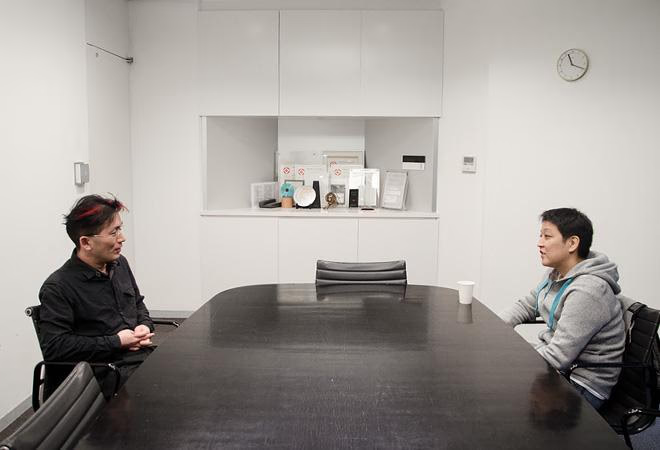
松野
うちのスタッフから「児嶋さんって、松野さんと同じ匂いがする」と言われたことがあります。立ち位置は違うんですけど、同じような時代を同じような環境のなかで生きてきた人なのかなって。 一緒に仕事をしていて大変だと感じるエピソードを語ればいろいろありますけど、それよりもバックグラウンドが近いからフラストレーションなく、いられるんだろうなと感じていました。
児嶋
さっき語ってくださった〝正しくある″というのは、自分でも仕事の上で大切にしていて、あるべき姿、過少でも過大でもないそのままをきちんと伝えたいという気持ちはいつもありますね。
松野
そうそうそう。だから、仕事の話をしていても、合うんだと思います。
児嶋
「これどうしよう?」という話になったときの判断基準が近い。
松野
例えば、スプーンがああいう形になったのは、相応の歴史を経て、使っている人たちが納得して、でのことですよね。それを無理矢理捻じ曲げて、結果使い辛くなるような意外性や斬新さは求める必要ないかなぁ、と。進化させることを考えるのは大事なことですけどね。
児嶋
そうですよね。
松野
クライアントさんのところでも、このスプーンの話はたまにするんですけど、児嶋さんには言わなくても伝わる感じがあって。僕が見ているのは児嶋さんを通したモノサスさんですが、たぶん、そういうところが近いんだろうなと思っています。
児嶋
最後にひとついいですか? 前から気になっていたのですが、髪の毛が赤いのはどうしてなんですか?
松野
髪の毛が赤いのですか! いつか聞かれるだろうなとは思ってました(笑)。 僕は地元で生まれ育って、今も住んでいるんですよ。だから、通っている美容院も、切ってくれる美容師さんも中学高校くらいから変わっていなくて、高校卒業したとき、「おめでとう!」って金髪メッシュにしてくれたんです。それが赤になったのは、二十歳のとき。 「成人おめでとう」てことで、赤くしてくれたんですね(笑)。それ以来ずっと赤いんです。 で、そういう経緯がありつつ、赤い髪が自分の弱い部分を補ってくれているという感覚もあるんですよね。どちらかと言えば、控えめな性格なので、ガツガツ「俺は」と主張するタイプではないんですが、髪が赤いことで黙っていても演出されるというか。 今となっては、髪の毛黒くしてきたらみんなから心配されるかもしれないくらいアイデンティティになっちゃってるから。もう、いけるとこまで赤いままで(笑)。
児嶋
じゃあ、色が変わったらなにか大きなターニングポイントがやってきたのだ、と。
松野
そうですね。そう思っていただいていいです(笑)。
松野 睦 (まつの・むつみ)さんプロフィール
アートディレクター。1975年生まれ。東京都出身。多摩美術大学卒。1998年株式会社アクシス入社。Webサイトのデザインやコーディングを中心に、AXIS誌などのエディトリアルデザイン、グラフィックデザインも行う。
(インタビュー構成:佐口賢作)

